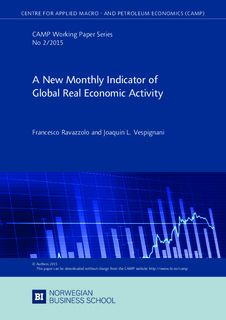A New Monthly Indicator of Global Real Economic Activity
Working paper
Permanent lenke
http://hdl.handle.net/11250/2364615Utgivelsesdato
2015Metadata
Vis full innførselSamlinger
Sammendrag
In modelling macroeconomic time series, often a monthly indicator of global real economic
activity is used. We propose a new indicator, named World steel production, and compare it
to other existing indicators, precisely the Kilian’s index of global real economic activity and
the index of OECD World industrial production. We develop an econometric approach based
on desirable econometric properties in relation to the quarterly measure of World or global
gross domestic product to evaluate and to choose across different alternatives.
The method is
designed to evaluate short-term, long-term and predictability properties of the indicators.
World steel production is proven to be the best monthly indicator of global economic activity
in terms of our econometric properties. Kilian’s index of global real economic activity also
accurately predicts World GDP growth rates. When extending the analysis to an out-ofsample
exercise, both Kilian’s index of global real economic activity and the World steel
production produce accurate forecasts for World GDP, confirming evidence provided by the
econometric properties. Specifically, a forecast combination of the three indices produces
statistically significant gains up to 40% at nowcast and more than 10% at longer horizons
relative to an autoregressive benchmark.
